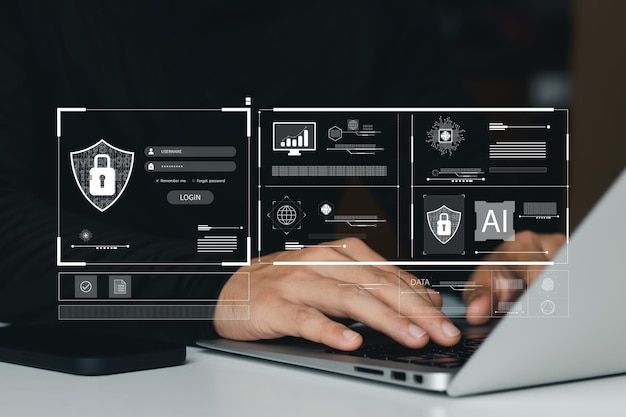A Guide to Cybersecurity Best Practices for Small Business Owners
In today’s digital age, cybersecurity is a critical concern for small business owners striving to protect their valuable data and maintain online security. With cyber threats evolving rapidly, implementing effective security measures is essential to safeguard sensitive information from potential breaches. Small businesses, often operating with limited resources, face unique challenges in fortifying their digital defenses. This guide aims to provide a comprehensive overview of cybersecurity best practices tailored specifically for small enterprises, offering practical advice to help secure their digital assets. Whether you’re an IT professional or a business owner, understanding these strategies is key to ensuring robust data protection and peace of mind.## Understanding Cybersecurity Basics

Cybersecurity is a fundamental aspect of modern business operations. This section explores the core concepts of cybersecurity for small businesses, emphasizing the importance of data protection and highlighting common online security threats.
Defining Cybersecurity for Small Business
Cybersecurity for small businesses involves protecting digital assets, networks, and sensitive information from unauthorized access, theft, or damage. It encompasses a range of practices, tools, and strategies designed to safeguard business operations in the digital realm.
Small businesses often face unique challenges in implementing cybersecurity measures due to limited resources and expertise. However, the importance of robust cybersecurity cannot be overstated, as small enterprises are increasingly targeted by cybercriminals.
Effective cybersecurity for small businesses typically includes elements such as firewalls, antivirus software, secure password policies, and employee training. These measures work together to create a comprehensive defense against various cyber threats.
Importance of Data Protection
Data protection is crucial for small businesses to maintain customer trust, comply with regulations, and safeguard valuable business information. Proper data protection practices help prevent financial losses, reputational damage, and legal consequences that can result from data breaches.
Small businesses handle various types of sensitive data, including customer information, financial records, and proprietary business data. Protecting this information is not just a best practice; it’s often a legal requirement under data protection regulations like GDPR or CCPA.
Implementing strong data protection measures also provides a competitive advantage. Customers are more likely to trust and do business with companies that demonstrate a commitment to protecting their personal information.
Online Security Threats to Watch
Small businesses face a variety of online security threats that can compromise their operations and data. Common threats include malware infections, phishing attacks, ransomware, and social engineering tactics.
Malware, such as viruses and trojans, can infiltrate business systems through infected emails, downloads, or compromised websites. These malicious programs can steal data, disrupt operations, or provide unauthorized access to cybercriminals.
Phishing attacks attempt to trick employees into revealing sensitive information or login credentials. These attacks often come in the form of deceptive emails or websites that mimic legitimate sources.
Ransomware is a particularly dangerous threat that encrypts business data and demands payment for its release. Small businesses are often targeted due to their perceived vulnerability and willingness to pay to recover critical data.
Implementing Security Measures
Implementing robust security measures is essential for protecting small businesses from cyber threats. This section covers key strategies and tools for enhancing online security and fostering a security-conscious culture within the organization.
Essential Security Measures
Implementing essential security measures forms the foundation of a strong cybersecurity posture for small businesses. These measures act as the first line of defense against common cyber threats and help protect sensitive data from unauthorized access.
One of the most critical security measures is the use of strong, unique passwords for all accounts and systems. Passwords should be complex, combining uppercase and lowercase letters, numbers, and special characters. Implementing a password manager can help employees create and maintain strong passwords without resorting to easily guessable combinations.
Regular software updates and patch management are also crucial. Cybercriminals often exploit known vulnerabilities in outdated software to gain access to systems. By keeping all software, including operating systems, applications, and security tools, up to date, businesses can close potential security gaps.
Tools for Enhanced Online Security
A variety of tools can help small businesses enhance their online security posture. These tools provide additional layers of protection against cyber threats and help monitor for potential security incidents.
Firewalls are essential for controlling incoming and outgoing network traffic. They act as a barrier between trusted internal networks and potentially dangerous external networks, such as the internet. Both hardware and software firewalls can be effective in protecting small business networks.
Antivirus and anti-malware software are crucial for detecting and removing malicious programs that may attempt to infiltrate business systems. These tools should be installed on all devices and kept up to date to ensure protection against the latest threats.
Virtual Private Networks (VPNs) can provide secure, encrypted connections for remote workers accessing company resources. This is particularly important for businesses with employees who work from home or frequently travel.
Creating a Secure Culture
Creating a culture of security within a small business is vital for maintaining robust cybersecurity. This involves fostering awareness, promoting best practices, and encouraging all employees to take an active role in protecting the company’s digital assets.
Regular training sessions can help employees understand the importance of cybersecurity and their role in maintaining it. These sessions should cover topics such as identifying phishing attempts, safe browsing practices, and the proper handling of sensitive information.
Establishing clear security policies and procedures is essential. These should outline expectations for employee behavior, such as proper use of company devices and networks, guidelines for creating and managing passwords, and protocols for reporting suspected security incidents.
Encouraging open communication about security concerns can help identify potential vulnerabilities before they become serious issues. Creating a non-punitive environment where employees feel comfortable reporting suspicious activities or potential security breaches is crucial for maintaining a strong security posture.
Protecting Sensitive Data

Protecting sensitive data is a critical aspect of cybersecurity for small businesses. This section explores strategies for safeguarding valuable information, implementing encryption practices, and ensuring data privacy.
Data Protection Strategies
Effective data protection strategies are essential for small businesses to safeguard sensitive information from unauthorized access, theft, or loss. These strategies involve a combination of technical measures, policies, and best practices.
One key strategy is data classification, which involves categorizing data based on its sensitivity and importance. This allows businesses to apply appropriate security measures to different types of data, focusing resources on protecting the most critical information.
Implementing access controls is another crucial strategy. This involves restricting access to sensitive data on a need-to-know basis, ensuring that employees only have access to the information necessary for their roles. Regular audits of access rights can help maintain the principle of least privilege.
Backup and recovery procedures are also vital for data protection. Regular backups, stored securely off-site or in the cloud, can help businesses recover quickly from data loss due to cyber attacks, hardware failures, or other incidents.
Encryption Practices for Security
Encryption is a powerful tool for protecting sensitive data, both at rest and in transit. It involves converting data into a coded form that can only be deciphered with the correct encryption key, making it unreadable to unauthorized users.
For data at rest, full-disk encryption can be used to protect information stored on computers, servers, and mobile devices. This ensures that data remains secure even if a device is lost or stolen.
When transmitting sensitive data over networks, especially the internet, encryption protocols such as SSL/TLS should be used. This protects data in transit from interception and tampering.
Email encryption is also important for businesses that frequently send sensitive information via email. Solutions like PGP (Pretty Good Privacy) or S/MIME (Secure/Multipurpose Internet Mail Extensions) can be used to encrypt email contents and attachments.
Ensuring Data Privacy
Ensuring data privacy is crucial for maintaining customer trust and complying with data protection regulations. This involves implementing measures to protect personal information and respecting individuals’ rights regarding their data.
Privacy policies should clearly communicate how the business collects, uses, and protects customer data. These policies should be easily accessible and written in clear, understandable language.
Implementing data minimization practices can help reduce privacy risks. This involves collecting and retaining only the data necessary for specific business purposes, and securely disposing of data that is no longer needed.
Regular privacy impact assessments can help identify and address potential privacy risks in business processes and systems. These assessments can guide the implementation of privacy-enhancing technologies and practices.
Training and Awareness

Employee training and awareness are crucial components of a comprehensive cybersecurity strategy. This section focuses on educating employees about cybersecurity best practices, recognizing phishing attempts, and fostering a security-first mindset within the organization.
Educating Employees on Cybersecurity
Educating employees on cybersecurity is essential for creating a strong defense against cyber threats. Well-informed employees can act as a human firewall, helping to prevent security incidents and protect sensitive business data.
Training programs should cover a range of topics, including password security, safe internet browsing practices, and the proper handling of sensitive information. These programs should be ongoing and regularly updated to address new and evolving threats.
Practical, hands-on training exercises can be particularly effective. For example, simulated phishing attacks can help employees learn to identify and respond to real-world threats.
Interactive workshops and group discussions can encourage employees to share their experiences and learn from each other. This collaborative approach can help reinforce key cybersecurity concepts and best practices.
Recognizing Phishing Attempts
Phishing attacks remain one of the most common and effective methods used by cybercriminals to gain unauthorized access to sensitive information. Training employees to recognize and respond to phishing attempts is crucial for preventing these attacks.
Key indicators of phishing emails include unexpected or urgent requests, generic greetings, suspicious attachments, and links that don’t match the purported sender’s domain. Employees should be trained to scrutinize these elements before taking any action.
Practical exercises, such as reviewing sample phishing emails, can help employees develop the skills to identify suspicious messages. Regular phishing simulations can also test and reinforce these skills in a controlled environment.
Establishing clear procedures for reporting suspected phishing attempts is important. This allows the IT team to investigate potential threats and take appropriate action to protect the organization.
Building a Security-first Mindset
Fostering a security-first mindset among employees is crucial for maintaining a strong cybersecurity posture. This involves creating a culture where security is seen as everyone’s responsibility, not just the IT department’s.
Regular communication about cybersecurity topics can help keep security top-of-mind for employees. This can include sharing updates on new threats, tips for staying secure, and success stories of prevented attacks.
Encouraging employees to apply cybersecurity best practices in their personal lives can reinforce these habits at work. This might include guidance on securing home networks, using password managers, and protecting personal devices.
Recognizing and rewarding employees who demonstrate good security practices can help motivate others to follow suit. This positive reinforcement can contribute to a culture where security is valued and prioritized throughout the organization.
Planning for the Future
Planning for the future is essential for maintaining strong cybersecurity in an ever-evolving threat landscape. This section focuses on developing a comprehensive cybersecurity plan, conducting regular security audits, and staying updated with emerging trends and threats.
Developing a Cybersecurity Plan
A comprehensive cybersecurity plan provides a roadmap for protecting a small business’s digital assets and responding to potential security incidents. This plan should be tailored to the specific needs and resources of the business.
The plan should include clear policies and procedures for various aspects of cybersecurity, such as data protection, access control, incident response, and employee training. These policies should be regularly reviewed and updated to ensure they remain effective and relevant.
Risk assessment is a crucial component of the cybersecurity plan. This involves identifying potential threats and vulnerabilities, assessing their potential impact, and prioritizing mitigation efforts based on the level of risk.
The plan should also outline roles and responsibilities for cybersecurity within the organization. This ensures that everyone understands their part in maintaining the company’s security posture.
Regular Security Audits
Regular security audits are essential for identifying vulnerabilities, assessing the effectiveness of existing security measures, and ensuring compliance with relevant regulations and standards.
These audits should cover various aspects of the business’s IT infrastructure, including networks, systems, applications, and data storage. Both internal and external audits can provide valuable insights into the organization’s security posture.
Vulnerability scans and penetration testing can help identify potential weaknesses in the company’s defenses. These tests simulate real-world attack scenarios to uncover vulnerabilities that might be exploited by cybercriminals.
The results of security audits should be carefully analyzed and used to inform improvements to the cybersecurity plan. This continuous improvement process helps ensure that the organization’s security measures remain effective against evolving threats.
Staying Updated with Trends
Staying informed about emerging cybersecurity trends and threats is crucial for maintaining an effective security posture. The threat landscape is constantly evolving, and new vulnerabilities and attack methods emerge regularly.
Subscribing to reputable cybersecurity news sources and threat intelligence feeds can help small businesses stay informed about the latest developments. Industry forums and professional networks can also be valuable sources of information and best practices.
Regularly reviewing and updating security tools and practices is important to address new threats. This might involve adopting new security technologies, updating existing tools, or modifying security procedures based on emerging best practices.
Participating in cybersecurity training and conferences can help IT staff and business leaders stay current with the latest trends and strategies in the field. This knowledge can be invaluable in planning for future security needs and challenges.
